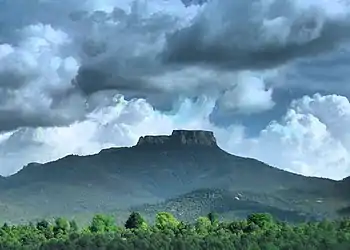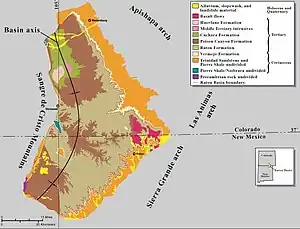Raton Mesa
Raton Mesa is the collective name of several mesas on the eastern side of Raton Pass in New Mexico and Colorado. The name Raton Mesa or Mesas has sometimes been applied to all the mesas that extend east for 90 miles (140 km) along the Colorado-New Mexico border from Raton, New Mexico and Trinidad, Colorado to the Oklahoma panhandle. These include Johnson Mesa, Mesa de Maya, and Black Mesa.[1]
| Raton Mesa (Mesa de Maya) | |
|---|---|
 | |
| Location | Las Animas County, Colorado, United States |
| Designated | 1967 |
The highest point of Raton Mesa, Fishers Peak, is located in Las Animas County, Colorado. The highest part of the mesa (4,183-acre (16.93 km2)) was made a National Natural Landmark in 1967. Raton mesas are volcanic in origin caused by lava flows which solidified into basalt. Over time the softer sedimentary rock surrounding the basalt eroded leaving several distinct large elevated tablelands with precipitous sides.[2]
Raton Mesa is part of the Raton Basin, a coal and natural gas producing region.
Description

Interstate Highway 25 through Raton Pass, 7,834 feet (2,388 m) in elevation, separates the foothills of the Sangre de Cristo Mountains to the west from the mesa country on the east. For this article, Raton Mesa is defined as the area east of Interstate 25 between Trinidad, Colorado and Raton, New Mexico, approximately 19 miles (31 km) south to north, and extending eastwards about 13 miles (21 km). Within this area are three distinct mesas separated by deep canyons: Fishers Peak Mesa in Colorado, with a maximum elevation of 9,633 feet (2,936 m), Bartlett Mesa, mostly in New Mexico, with a maximum elevation of 8,900 feet (2,700 m), and Barela/Horseshoe/Horse Mesa, straddling the Colorado/New Mexico state line, with a maximum elevation of 8,757 feet (2,669 m). The elevations at the foot of the mesas are 6,000 feet (1,800 m) or higher.[3]
The flat-topped mesas are mostly grassland, but their steep slopes are wooded with ponderosa pine the dominant species, joined by quaking aspen, Douglas fir, and white fir at higher elevations and pinyon, juniper, and Gambel oak at lower elevations. Mammal species include American black bear, cougar, mule deer, beaver, and especially elk which are seen in herds of more than 100 individuals.[4] Hunting, especially for elk, is popular in season on both public and private lands.[5]


No public roads reach the top of the mesas. The only public road which penetrates the area is through Sugarite Canyon State Park in New Mexico. It terminates shortly after crossing the border into Colorado at an altitude of 7,560 feet (2,300 m). This road provides access to the three publicly owned areas of Raton Mesa: Surgarite Canyon State Park 3,600 acres (15 km2) in New Mexico and Lake Dorothey State Wildlife Area 5,152 acres (20.85 km2) and James M. John State Wildlife Area 8,339 acres (33.75 km2) in Colorado.[6] From the parking area at Lake Dorothey, the summit of Fisher's Peak is a straight-line distance of about eight miles by an unmarked trail.[7]
Much of the Colorado portion of the Raton Mesa, including Fisher's Peak, was owned by the Crazy French Ranch until 2019 when the 19,200 acres (7,800 ha) ranch was purchased to become a Colorado state park. Funds to purchase the ranch came jointly from Great Outdoors Colorado, the funding arm of the Colorado Lottery, The Nature Conservancy, and The Trust for Public Land.[8]
References
- Keyes, Charles R. (1919), "The Hanging Gardens of the Mesa de Maya, The Geographic Review, Vol. 8, No. 3, pp. 145-152. Downloaded from JSTOR.
- Lee, Willis T. "The Raton Mesas of New Mexico and Colorado" Geographic Review, Vol 11, No 3 (July 1921), pp. 384-397
- Google Earth
- Jones, Cheri A. (2002) "Mammals of the James M. John and Lake Dorothey State Wildlife Areas, Las Animas County, Colorado", Proceedings of the Denver Museum of Nature and Science, Series 4, No. 3, pp. 1-14
- Hunting in Las Animas County, Colorado. Sangres.com. http://www.sangres.com/stateco/lasanimas.htm#.VOtPPPldW3k, accessed 23 Feb2015
- "Colorado Parks and Wildlife", http://www.cpw.state.co.us/swa/Lake%20Dorothey%20SWA, accessed 23 Feb 2015
- Google Earth
- "Agreement Reached on Fisher's Peak / Crazy French Ranch". Great Outdoors Colorado. 2019-01-04. Retrieved 2020-08-14.
Further reading
- Willis Thomas Lee; Frank Hall Knowlton (1917). Geology and Paleontology of the Raton Mesa and Other Regions in Colorado and New Mexico (PDF). Washington: GPO.
- United States. National Park Service (1965). Raton Mesa National Monument: A Proposal. U.S. Department of the Interior, National Park Service.